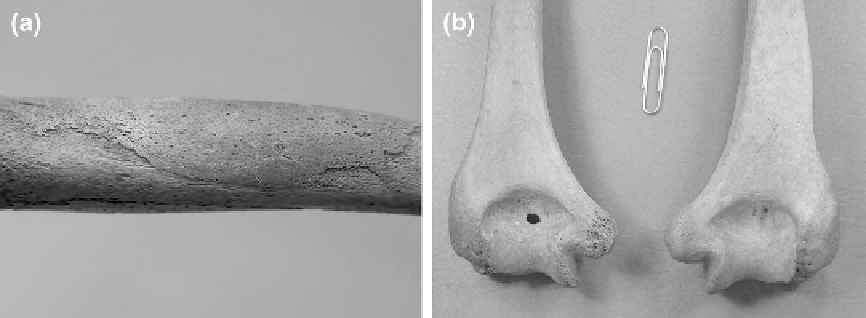Biology Reference
In-Depth Information
the roof of the eye orbits (
Figure 7.1
c). These are pathologies of childhood that have been differ-
entially linked to anemia, scurvy, parasite load, inflammation, genetic conditions (e.g., sick-
lemia, thallasemia), and vitamin deficiency (
Angel, 1966; Stuart-Macadam, 1987, 1992
;
Stuart-Macadam and Kent, 1992;
Ortner and Erickson, 1997; Ortner, 2003; Wapler et al., 2004;
Walker et al., 2009; Oxenham and Cavill, 2010
). Both pathological conditions are routinely
used as measures of stress that are compared between subsistence economies, sociopolitical
circumstances, and ecological circumstances (e.g.,
Kent, 1986; Hirata, 1990
; Mittler and Van
Gerven, 1994;
Robledo et al., 1995; Larsen and Sering, 2000
; Fairgreve andMolto, 2000;
Salvadei
et al., 2001; Facchini et al., 2004; Sullivan, 2005; Buzon, 2006; Keenleyside and Panayotova,
2006
). Indeed, when nothing is known about a particular osteological sample, cribra orbitalia
and porotic hyperostosis are invariably part of the first wave of information collected.
Reactive Changes on Bone
Equally fundamental health status information that is routinely collected in analytical
paleopathology is the reactive changes visible on the cortical surface of bone that flag chronic
infection or inflammation (caused by traumatic injury, burns, physical or chemical irritant,
etc.) (
Lallo et al., 1978; Rogers and Waldron, 1989
). See
Figure 7.2a and 7.2
b. The morphology
of these reactive changes is similar, if not identical, in many pathological processes (
Weston,
2008
). As a result, and although inflammation is also a likely cause, the presence of this
generic reactive change is bioarchaeologically referred to as nonspecific infection. Often
this is discriminated as cortical change (periostitis) or internal spongy bone change (osteo-
myelitis) that additionally displays with dead (necrotic) bone (sequestrum) and a drain
(cloaca) for exuded pus as well as a shell of new bone growth (involucrum).
Certain disease processes are known as specific diseases because they differentially affect
certain bones or are manifested by particular types of lesions. A number of specific diseases
such as tuberculosis, treponemal disease, leprosy, and brucellosis have epidemiological and
FIGURE 7.2
(a) Periostitis as new (woven) bone plaque deposited superior to the cortical surface. (b) Periostitis
as the resultant shaft (diaphyseal) expansion of mature (lamellar) bone. Note the shaft of the humerus on the left
compared to the one on the right.


